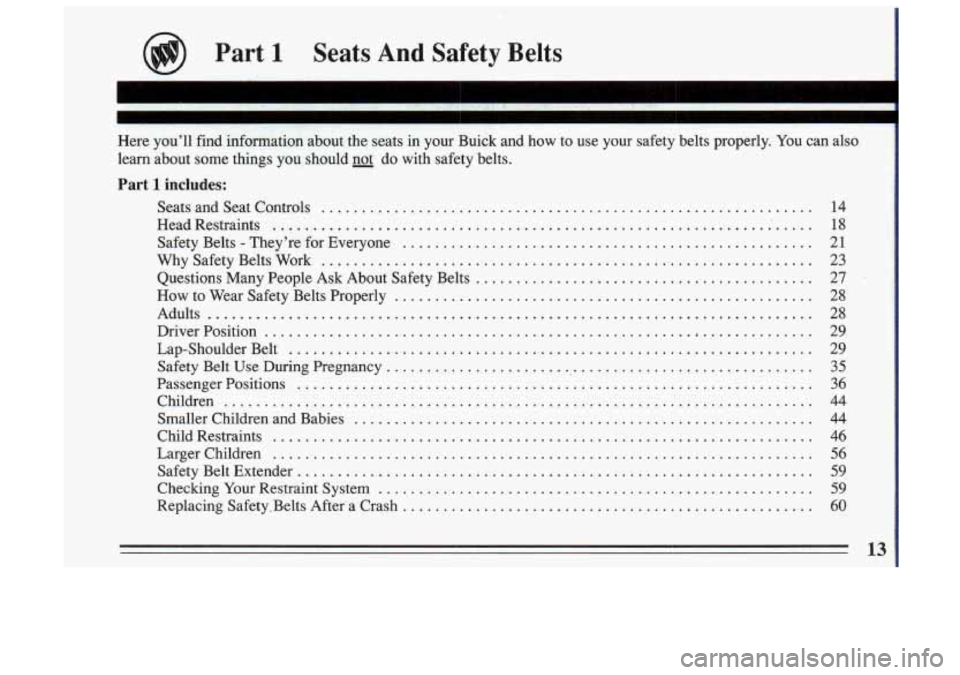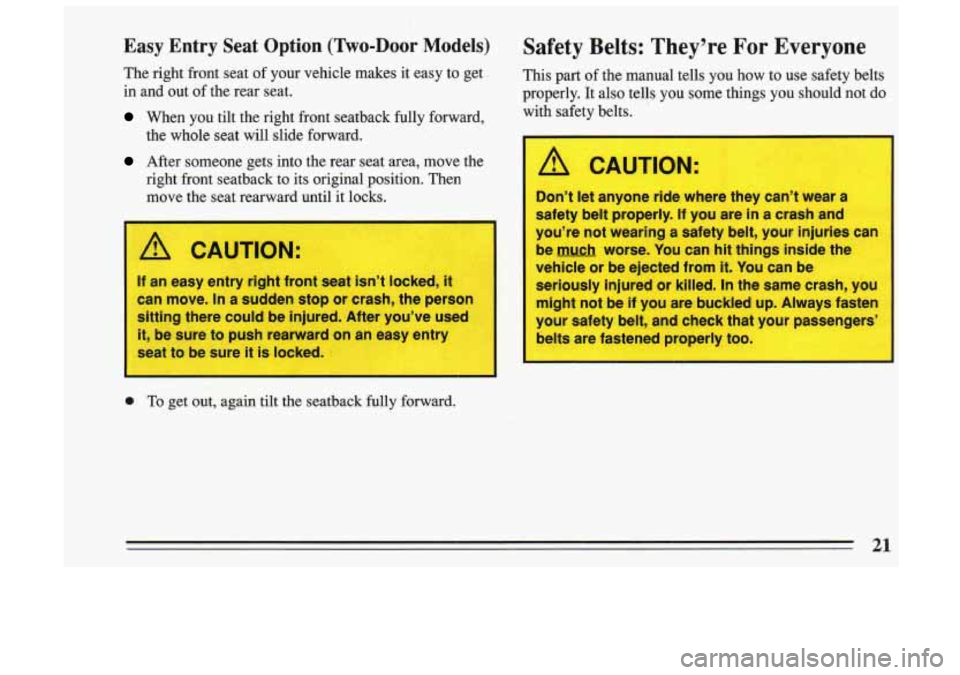Page 10 of 306

Table of Contents
How to Use this Manual ................................................................. 10
Seats and Safety Belts
............................ .:. ................................... 13
FeaturesandControls
.................................................................. 61
Comfort Controls and Audio Systems
..................................................... 119
YourDrivingandtheRoad
.............................................................. 137
ProblemsontheRoad
.................................................................. 185
This part tells you how to use your manual and includes safety and vehicle damage warnings & symbols.
This part tells you how
to use your seats and safety belts properly.
This part explains how to start and operate your Buick.
This part tells you how to adjust the ventilation
& comfort controls and how to operate your sound system.
Here you’ll find helpful information and tips about the road and how to drive under different conditions.
This part tells you what to do if you have a problem while driving, such as a flat tire or engine overheating.
Here the manual tells you how to keep your Buick running properly and looking good.
This part tells you when to perform vehicle maintenance and what fluids and lubricants
to use.
This part tells you how to contact Buick for assistance and how to get service publications. It also gives
you information on “Reporting Safety Defects.’’
Here’s an alphabetical listing
of almost every subject in this manual. You can use it to quickly find
something you want to read.
ServiceandAppearanceCare ............................................................ 215
Maintenanceschedule
.................................................................. 265
Customer Assistance Information
........................................................ 285
Index
........................................................................\
........ 293
9
Page 13 of 306

Vehicle Symbols
These are some of the symbols you will. find -on your vehicle.
For example,
these symbols
are used on an
original battery:
CAUTION
INJURY
PROTECT EYES BY
SHIELDING
Q
CAUSTIC
ACID COULD CAUSE
BA~~RY
BURNS AVOID
SPARKS
OR
FLAMES
SPARK
OR ,\I/,
COULD pq
FLAME
EXPLODE BATTERY
These symbols
are important
for you and
your passengers
whenever your
vehicle- is
driven:
FASTEN SEAT 4
BELTS
POWER
WINDOW
These symbols
have to do with
your lights:
SIGNALS e 9
TU-RN
HIGH BEAM
OR = =o
FOG LAMPS # 0
These symbols
are on some of
your controls:
WINDSHIELD ' ' '
. WASHER
CI 0s
-tO -1
WINDSHIELD
WASHER 8
wI*DsHIELDw DEFROSTER
WINDOW
Ltft,
REAR
DEFOGGER
VENTILATING FAN
3f
HEADLAMP -
WIPER
WASHER
EQ
L
~
These symbols
are used
on
warning and
indicator lights:
COOLANT F-
TEMP *-
ENGINE
CHARGING BATTERY
SYSTEM
RADIATOR
a
COOLANT
FUEL @
ENGINE OIL e,
PRESSURE
TEMP
OIL &
ANTILOCK (@)
BRAKE
Here are some
other symbols
you may see:
FUSE
RAD10 k
VOLUME
CONDITIONING
AIR e
HATCHBACK TRUNK
RELEASE
LIGHTER
1-i
HORN
SPEAKER
12
Page 14 of 306

Part 1 Seats And Safety Belts
Here you’ll find information about the seats in your Buick and how to use your safety belts properly\
. You can also
learn about some things you should
not do with safety belts .
Part 1 includes:
SeatsandSeatControls ............................................................. 14
Head Restraints
............................................................. .. ..... 18
Safety Belts
. They’re for Everyone ................................................... 21
WhySafetyBeltsWork
............................................................. 23
Questions Many People Ask About Safety Belts
.......................................... 27
How to Wear Safety Belts Properly
.................................................... 28
Adults
........................................................................\
.... 28
DriverPosition
.................................................................... 29
Lap-ShoulderBelt
................................................................. 29
Safety Belt
Use During Pregnancy ...................................................... 35
PassengerPositions
................................................................ 36
Children
........................................................................\
. 44
Smaller Children and Babies ......................................................... 44
ChildRestraints ................................................................... 46
LargerChildren ................................................................... 56
SafetyBeltExtender
................................................................ 59
Checking Your Restraint System
...................................................... 59
Replacing Safety.Belts After a Crash
................................................... 60
13
Page 19 of 306
CAUTION: (Continued)
The, shoulder belt can't
do its job because it
won't be against your
body. Instead, it will be in
front
of you. In a crash you could do into it,
receiving neck or other injuries.
The
lap belt can't.do its job either. In a crash' the
belt could go up over your abdomen. The belt
forces would be there, not at your pelvic bones.
This could cause serious internal injuries.
For proper protection when the vehicle is in
motion, have the seatback upright. Then sit well
back
in the seat and wear you afety belt
properly.
Head Restraints
Y
Slide the head restraint up or down so that the top of the
restraint
is closest to the top of your ears.
This position reduces the chance
of a neck injury in a
crash.
Page 22 of 306

Easy Entry Seat Option (Two-Door Models)
The right front seat of your vehicle makes it easy to get
in and out of the rear seat.
When you tilt the right front seatback fully forward,
the whole seat will slide forward.
After someone gets into the rear seat area, move the
right front seatback to its original position. Then
move the seat rearward until it locks.
Safety Belts: They’re For Everyone
This part of the manual tells you how to use safety belts
properly. It also tells you some things you should not do
with safety belts.
If an easy entry right front seat isn’t locked, it
can move. In a sudden stop or crash, the person
sitting there could be injured. After you’ve used
~
it, be sure to push rearward on an easy entry
seat
to be sure it is locked. I
/! CAUTION: I
Don’t let anyone ride where they can’t wear a
safety belt properly. If you are
in a crash and
you’re not wearing a safety belt, your injuries can
be much worse. You can
hit things inside the
vehicle or be ejected from
it. You can be
seriously injured or killed.
In the same crash, you
might not be
if you are buckled up. Always fasten
your safety belt, and check that your passengers’
belts are fastened properly too.
@ To get out, again tilt the seatback fully forward.
21
Page 24 of 306
Why Safety Belts Work
When you ride in or on anything, you go as fast as it
goes.
When the bike hits the block, it stops. But the child
keeps going!
For example, if the bike is going 10 mph (16 km/h), so
is the child.
23
Page 27 of 306
or the instrument panel ... or the safety belts!
With safety belts, you slow down as the vehicle does.
You get more time to
stop. You stop over more distance,
and your strongest bones take the forces. That's why
safety belts make such good sense.
Page 28 of 306

Here Are Questions Many People Ask
About Safety Belts
-- and the
Answers
Won’t I be trapped in the vehicle after .an
accident if I’m wearing a safety belt?
A: You could be -- whether you’re wearing a safety
belt or not. But you can easily unbuckle a safety
belt, even
if you’re upside down. And your chance
of being conscious during and after an accident, so
you unbuckle and get out, is much greater if
you are belted.
Q: Why don’t they just put in air bags so people
A: “Air bags,” or Supplemental Inflatable Restraint
won’t have to wear safety belts?
systems, are in some vehicles today and will be in
more of them in the future. But they are
supplemental systems only
-- so they work with safety belts, not instead
of them. Every “air
bag’’
system ever offered for sale has required the use of
safety belts. Even if you’re in a vehicle that has “air
bags,” you still have
to buckle up to get the most
protection. That’s true not only in frontal collisions,
but especially in side and other collisions.
&: If I’m a good driver, and I never drive far from
A: You may be an excellent driver, but if you’re in an,
accident
-- even one that.isn’t your fault -- you and
your passengers can be hurt. Being a good driver
doesn’t protect you from things beyond your
control, such as bad drivers.
home, why should I wear safety belts?
Most accidents occur within 25 miles (40 km) of
home. And the greatest number of serious injuries
and deaths occur at speeds
of less than 40 mph
(65 km/h).
Safety belts are for everyone.
27